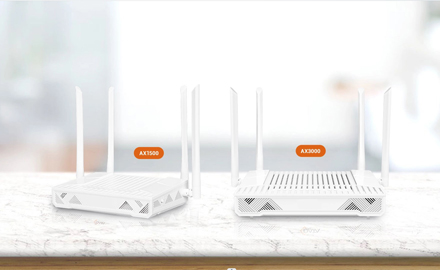The difference between an AX1800 ONU (Optical Network Unit) and an AX3000 ONU lies primarily in their respective capabilities, speed, and performance. While both devices serve as endpoints in fiber optic networks, they differ significantly in terms of their specifications and intended use cases.

1. Wireless Standards: Both AX1800 ONU and AX3000 ONU belong to the WiFi 6 (802.11ax) standard, representing the latest generation of wireless technology. However, the numbers (1800 and 3000) denote the maximum theoretical data rates (in Mbps) each ONU can achieve across all its bands and channels.
2. Data Rates: The primary difference between AX1800 ONU and AX3000 ONU lies in their maximum theoretical data rates. An AX1800 ONU can achieve maximum theoretical speeds of up to 1800 Mbps, while an AX3000 ONU can reach speeds of up to 3000 Mbps. This difference in data rates can significantly impact the overall performance and speed of the wireless network.
3. Channel Bandwidth: The channel bandwidth supported by each ONU influences the difference in data rates. AX1800 ONUs typically support narrower channel widths, such as 80 MHz or even 40 MHz, while AX3000 ONUs often support wider channel widths, such as 160 MHz. Wider channel widths enable higher data rates by allowing more data to be transmitted simultaneously.
4. Number of Spatial Streams: The number of spatial streams supported by each ONU also contributes to the difference in data rates. AX1800 ONUs typically support fewer spatial streams compared to AX3000 ONUs. Spatial streams are independent data streams transmitted simultaneously by the ONU, and ONUs with more spatial streams can achieve higher data rates.
5. Antenna Configuration: The antenna configuration of each ONU can affect its performance and coverage area. AX3000 ONUs often feature more advanced antenna configurations, including multiple high-gain antennas, beamforming technology, and advanced signal processing techniques. These features optimize signal strength, coverage, and reliability, resulting in improved overall performance.

6. Processor and Hardware: AX3000 ONUs generally come equipped with more powerful processors and hardware components compared to AX1800 ONUs. These enhancements enable AX3000 ONUs to handle higher data loads, support more simultaneous connections, and provide better overall performance in demanding network environments.
7. Features and Functionality: While both AX1800 ONUs and AX3000 ONUs support the core features of the WiFi 6 standard, AX3000 ONUs may offer additional features and functionality. These may include advanced Quality of Service (QoS) capabilities, support for more concurrent devices, enhanced security features, and integration with smart home ecosystems.
8. Price: Due to differences in specifications and performance capabilities, AX3000 ONUs are typically priced higher than AX1800 ONUs. The price difference reflects additional features, higher data rates, and overall better performance offered by AX3000 ONUs.
9. Use Cases: The choice between AX1800 ONUs and AX3000 ONUs depends on the specific needs and requirements of the user. AX1800 ONUs may be suitable for smaller households or users with moderate internet usage who prioritize affordability and value. On the other hand, AX3000 ONUs are ideal for users who demand higher performance, faster speeds, and support for a larger number of connected devices.

In summary, the main difference between AX1800 ONUs and AX3000 ONUs lies in their maximum theoretical data rates, which are influenced by factors such as channel bandwidth, number of spatial streams, antenna configuration, processor, hardware, features, and price. AX3000 ONUs offer higher data rates, more advanced features, and better overall performance compared to AX1800 ONUs, making them suitable for users with demanding networking needs and requirements. Ultimately, the choice between AX1800 ONUs and AX3000 ONUs depends on factors such as budget, usage patterns, and desired performance levels.
 How are Huawei OLTs Classified?
How are Huawei OLTs Classified?
 The Future Trend of Optical Line Terminals (OLTs)
The Future Trend of Optical Line Terminals (OLTs)
 The Difference Between ONU and ONT
The Difference Between ONU and ONT
 Deployment Requirements of XG(S)-PON Network
Deployment Requirements of XG(S)-PON Network